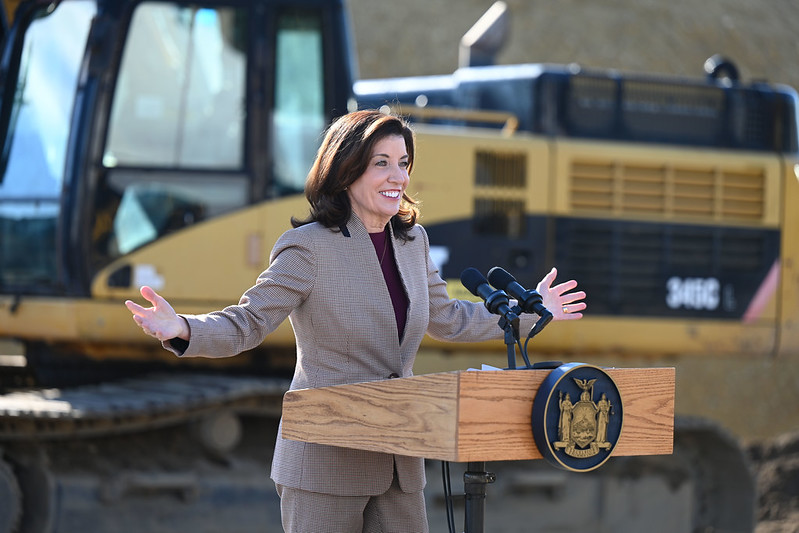
Governor Hochul (photo: Kevin P. Coughlin/Office of the Governor)
The most pressing issue facing New York is a lack of housing. A Regional Plan Association analysis shows that the state needs to build 817,000 more homes over the next decade to address shortages and meet expected population and job growth – the root cause of many symptoms currently ailing New York City.
For example, according to the city’s most recent Housing and Vacancy Survey, the median renter household makes $50,000 a year – but to afford a typically available apartment, renting for $2,750, that household needs to make $110,000. Is it any wonder that we have a nation-leading rate of chronic homelessness, with a nightly count surpassing 80,000 residents?
It was against this backdrop that Governor Hochul advanced ambitious housing goals this year, and it is against this backdrop that she, to her credit, will do so again next year despite the powerful and prevailing anti-housing forces. To be successful next session and to address the crisis of our age, however, there are several executive actions that the Governor can take on her own to spur housing development, regardless of local zoning.
With these actions, the Governor will show New Yorkers that she won’t back down from a challenge, and that “not in my backyard” isn’t an acceptable response.
First, the state should create affordable housing on the land it owns, as Governor Hochul has already signaled that she will do.
This is an opportunity for New York to fully maximize the potential of its own sites and lead by example. The Metropolitan Transit Authority owns some vacant parking lots on Long Island – it should follow in the footsteps of its California counterpart and work with other state agencies to redevelop them with housing. The state also has a number of abandoned psychiatric hospitals that could be redeveloped into housing – the 365 acres of the abandoned Kings Park Psychiatric Center, for example, are walking distance from a community college and an industrial park, and they’re only a mile-and-a-half from a Long Island Rail Road stop.
Second, Empire State Development (ESD), through the powers of the Urban Development Corporation, can build residential developments regardless of local zoning. This means that even without state land, ESD could use a “general project plan” to work with local landowners and private developers to build affordable and mixed-income housing. In exclusionary municipalities highly unlikely to ever allow affordable (or even multifamily) housing, this would be warranted.
Third and finally, the state should investigate localities that may be violating fair housing laws.
For instance, as a condition of approving a zoning change, Mount Pleasant recently forced Toll Brothers to age restrict a new development to residents over the age of 55 and local officials specifically cited school impact as a primary reason. While age-restricting a development is legal, it can be discrimination if you’re doing it specifically to exclude families with children.
Taken together, these measures are an important tool not just to create more housing, but also to affirmatively further fair housing. Restrictive zoning has not only driven up housing costs — it’s also resulted in sky-high levels of segregation.
The Regional Plan Association has demonstrated a clear correlation between exclusionary zoning and racial makeup of communities in the New York City region — with single-family zoned communities being almost entirely white, while multi-family-home communities are mostly inhabited by people of color. UC Berkeley found that New York has the most segregated school system in the country for Black students and the second most segregated school system for Latinos. And the Brookings Institute has shown that the New York City region has the second-highest level of Black-white residential segregation in the country, after only Milwaukee.
Over the last hundred years, zoning has become ever more restrictive across the state, and we have no reason to believe that municipalities will suddenly decide to do the right thing without state action. Instead, we must look to the state to solve the twin crises of housing supply and housing segregation.
State government respects leaders who are willing to play hardball. By taking strong, executive action on housing, the Governor can make it clear to all New Yorkers that she is going to tackle the biggest issues facing the state — and she will likely have greater leverage during next year’s budget process.
***
James Lloyd is the director of policy for the New York State Association for Affordable Housing. On Twitter @NYSAFAH.
***
Have an op-ed idea or submission for Gotham Gazette? Email This email address is being protected from spambots. You need JavaScript enabled to view it.




